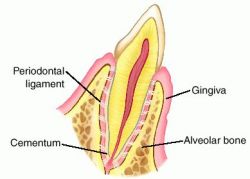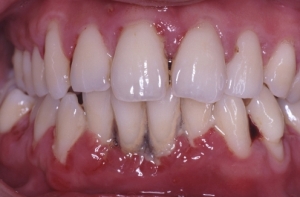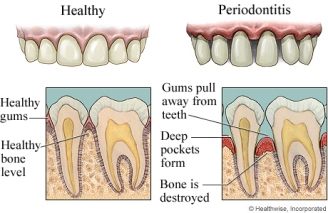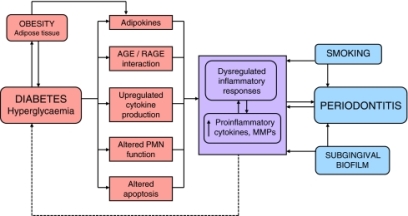What is peridontium? The term periodontium arises from the greek word “peri” meaning around and “odont” meaning tooth, thus it can be simply defined as tissues investing and supporting the teeth.1
Periodontium consist of…… The periodontium consist of the investing and supporting tissues of the tooth: gingiva, periodontal ligament,cementum, and alveolar bone.2
What is periodontal disease? Periodontal disease is an inflammatory disease that affects the soft and hard structures that support the teeth. In its early stage, called gingivitis. In the more serious form of periodontal disease called periodontitis.3 Plaque is the primary cause of gum disease. However, other factors can contribute to periodontal disease. These include: Hormonal, Illnesses, Medications, Bad Habits,Poor oral hygiene, Family history of dental diseases.
About Diabetes Mellitus
Diabetes mellitus affects an estimated 20 million Americans, about 35 to 40 percent of whom have not received a diagnosis. More than 9 percent of the adult population has diabetes, and both the incidence and prevalence are increasing every year. The two main types of diabetes are classified primarily on the basis of their underlying pathophysiology. Type 1 diabetes,no longer produces endogenous insulin, glucose is unable to enter target cells and remains in the bloodstream, resulting in sustained hyperglycemia. Type 2 diabetes, results from insulin resistance rather than from total absence of insulin production. Autoimmune destruction of β-cells does not occur in type 2 diabetes, and patients retain the capacity to secrete some insulin, although production often diminishes over time. Patients with type 2 diabetes can remain undiagnosed for years because hyperglycemia appears gradually and often without symptoms. Insulin resistance results in a decreased capacity to transfer glucose into target cells; thus, hyperglycemia develops.
The two-way relationship between diabetes and periodontitis.6
Diabetes has been unequivocally confirmed as a major risk factor for periodontitis The risk of periodontitis is increased by approximately threefold in diabetic individuals compared with non-diabetic individuals. The level of glycaemic control is of key importance in determining increased risk.

Periodontitis (clinical appearance) in a 22-year-old man with poorly controlled type 1 diabetes and severe periodontitis.
Exacerbated and dysregulated inflammatory responses are at the heart of the proposed two-way
interaction between diabetes and periodontitis (purple box), and the hyperglycaemic state results in various proinflammatory effects that impact on multiple body systems, including the periodontal tissues. Adipokines produced by adipose tissue include proinflammatory mediators such as TNF-α, IL-6 and leptin. The hyperglycaemic state results in deposition of AGEs in the periodontal tissues (as well as elsewhere in the body), and binding of the receptor for AGE (RAGE) results in local cytokine release and altered inflammatory responses.6
Neutrophil function is also altered in the diabetic state, resulting in enhancement of the respiratory burst and delayed apoptosis (leading to increased periodontal tissue destruction). Local production of cytokines in the periodontal tissues may, in turn, affect glycemic control
through systemic exposure and an impact on insulin signalling (dotted arrow). 6
Conclusion….
- Diabetic people are 2-4 times more susceptible to periodontal disease
- Periodontal infection then complicates glycemic control and enhances insulin resistance and hyperglycemia
- Poor glycemic control causes increased susceptibility to re infection and more severe periodontal disease.7
1. Essentials of Clinical Periodontology and Periodontics By Shantipriya Reddy 2. Carranza's Clinical Periodontology Michael G. Newman, Henry Takei, Perry R. Klokkevold, Fermin A. Carranza 3. http://www.perio.org/newsroom/periodontal-disease-fact-sheet 4. http://www.webmd.com/oral-health/guide/gingivitis-periodontal-disease 5. Periodontal disease and diabetes A two-way street Brian L. Mealey, DDS, MS JADA Vol 137, Oktober 2006 6. Periodontitis and diabetes: a two-way relationship P.M. Preshaw, A. L. Alba, and R. Taylor Diabetologia 2012 Jan (55)(1): 21-31 7. https://www.deltadentalmo.com/pdfs/.../2wayrelationship.pdf





ini yg keluar ujian kmrin yaaakk??
LikeLike
1 dari beberapa pertanyaan yg diajukan vi.
LikeLike
good job
LikeLike
penting ni! lumayan buat tambahan ilmu 🙂 keep on sharing Primichiii!
LikeLike
woww!!
LikeLike
Pingback: Seminar “Oxygene” (Improve Oral Hygiene With Oxygene, Clinical Research Update) | The Toothless Mind